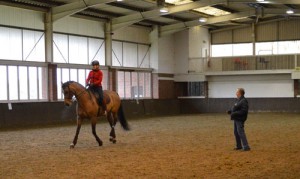Report on F & I Course Dressage Training with Jennie Loriston-Clarke FBHS
I find it hard to remember when I first became ‘aware’ of Jennie Loriston-Clarke but I expect it was at the beginning of the ‘70s when my family moved to Hampshire. It’s just that Jennie has always been there, leading the field, so the prospect of two training sessions with her, 45 years on, really focused my mind and preparation for this years F&I Course at Addington.
Jennie stood firm in the school from 8am-6pm on the first day and was upright in the same place at 8am the next day! An example to us all of stamina, fitness and enthusiasm for the job; offering the same benefits of her vast experience, to the last rider as to the first. Hardly surprising as this is J L-C but nevertheless most refreshing. I particularly enjoyed her friendly manner and down to earth approach, Jennie saw the root of the problem in both horse and rider, immediately, during the warm up and while allowing the riders to choose what they wanted to work on, she was totally involved throughout every session offering exercises and advice on improvement of the application and reception of the aids, not to mention the influence of the riders’ seat, which was not as good as it could be in several of us!
Riding with Jennie one ‘feels’ her knowledge of the workings of the horses mind and reactions, so while always horse and rider friendly, her directions are clear and simple enough for us both to understand and it is as if she were riding the horse herself. Quick to praise an improvement, clear and direct to aid a rider through resistance. Some of us worked in shared lessons and others individually. The first day it was not so easy for the line of spectators to hear but with a microphone on the second day we could all benefit from Jennie’s advice, even in the cafe, where it was remarked on how similar the comments were to those in the jumping arena. Of course this should not come as a surprise as the animals in both arenas were horses! The school surface rode rather firm the first day but with overnight harrowing allowed some shear and was more forgiving.
The general aim of all sessions was to ensure the horses moved forward, working evenly with suppleness into both reins and from there to develop a more uphill carriage with obedience to lighter aids. The riders must sit, even when stretching the horse down, with the shoulders above their hips, NOT in front, in order to ride effectively from the seat.
The horses must accept the riders’ leg aid is not given as a game into which the horse may lean as a mare or stallion would in their natural sexual behaviour in the wild. Colts should be got on top of as early as possible and then rewarded so they want to work for you with a healthy respect for the rider. Give them their ‘Baby time’ on the lunge to buck and play first but once the rider is on top they must submit or else problems can come when they fight back later on.
Jennie used questions to discover the riders’ view of a situation: “Do you think you’re upright yet?”
She emphasised how the way we sit with shoulders back and tummy muscles in action will help the horse to come up and how good the Germans are in their core strength resulting in less need of the leg.
Jennie helped a variety of horses and riders from Pre-Prelim to Eventers and on to Grand Prix. At whatever level they needed to be constantly steady in the contact and reactive to the aids. Comments I had ringing in my ears overnight were:
“ Do you understand?” “Does that make sense?” “Are you with me?”
“ COME ON! Don’t let him dawdle” “Upright seat, bend to the inside, use inside leg and seat to ride the trot. USE your inside leg! Make it listen! It doesn’t matter if he gets a bit upset – it’s brain dead otherwise!”
The horses must listen to the leg not ignore it, then submission comes. Get a reaction then reward the reaction by sitting quieter.
Ask a question then reward good movements with hands down and relaxed elbows. Be fair to the horse by being strict with yourself as a rider, so that even a 4 yr old is ridden forward in transitions, don’t allow the horse to drop behind the leg otherwise you have to correct it which is unfair to the horse. At 3/4yrs 20 minutes schooling is enough in order to preserve the soundness. Remember stallions tend to learn more quickly than other horses, both good and bad habits!
To develop the medium trot ride the trot forward and squeeze the horse to the straightness, it’s easier to ride on the long side but don’t throw him on his front. The rider was advised to think ‘uphill’ rather than speed and to ‘Look Up’ which helped the horse to stay in a better rhythm and uphill carriage. Ride the lengthening in shoulder in to bring it off the inside shoulder, remember to use inside leg to ride the corner.
“If you’re going to leg-yield Get Over There! At 7yrs old you must stretch the brain towards maturity or they fall down on you and get bored!”
“Ride forward with your backside not with your shoulders forward!”
“Don’t fight to get the horse ‘On the bit’- ASK!”
Much suppling work was done using travers in trot and canter, on straight lines and on circles but always increasing the activity of the hind legs. The canter should move on and back easily and this in turn improves the trot. While stretching the horse at the end of a session the rider must remain upright in rising trot not collapse forward onto the horse’s shoulders.
Working in walk on pirouettes, “Ask then reward with less leg, the horse should give the work to you willingly, check the contact”. A half pirouette was used into a half pass, keeping the walk alive and making a half halt in the pirouette so the first step was small, increasing as it developed.
A horse kicked out to the leg aid and the rider was advised to ‘reinforce the leg with the whip that’s what you’ve got it for’ until it stopped answering back, then Jennie explained how the aid given to a mare or stallion should be light and quick then rewarded in order to stop them pushing into your aid. It is important to sit light enough to allow the horses back up under the rider and then if needed shake them off the rein.
Much use was made of shoulder in to lighten the forehand and then medium steps in the half pass with the horse and rider both looking upwards and forwards!
Jennie illustrated how a horse falling on to the hand will come off the bit when the rider let go of the reins as it was relying on the rider to support it ‘on the bit’ rather than work in self-carriage. A horse on the forehand will go slightly crooked to avoid treading on itself in Medium trot so will not be straight. The rider should build the power rising and let it happen rather than rushing it.
Canter work included riding a circle then forward straight and using a smaller circle to aid the collection, being certain to keep the quarters on track with the outside leg. Medium on the long side must be followed by a clear transition over 2 strides to collection at the quarter marker. Aim for collection but then allow working canter to ensure a transition is shown that is clear enough for the judges to recognise!
Always use shoulder in to prepare for a simple change to ensure straightness is maintained.
This is only a small part of what Jennie gave the riders on this years course but it was super to hear many similar phrases from Nick Turner in the jumping arena. In particular “Ride forward for changes” “Eyes up to the fence as in the dressage, to keep the uphill balance”.
At the end of the second day Jennie said how much she had enjoyed working with the variety of horses and how good it is that so many BHS qualified Instructors are still pursuing their own riding careers. I am certain that everyone is very much looking forward to receiving help from Jennie again.
Report by Nikki Herbert

